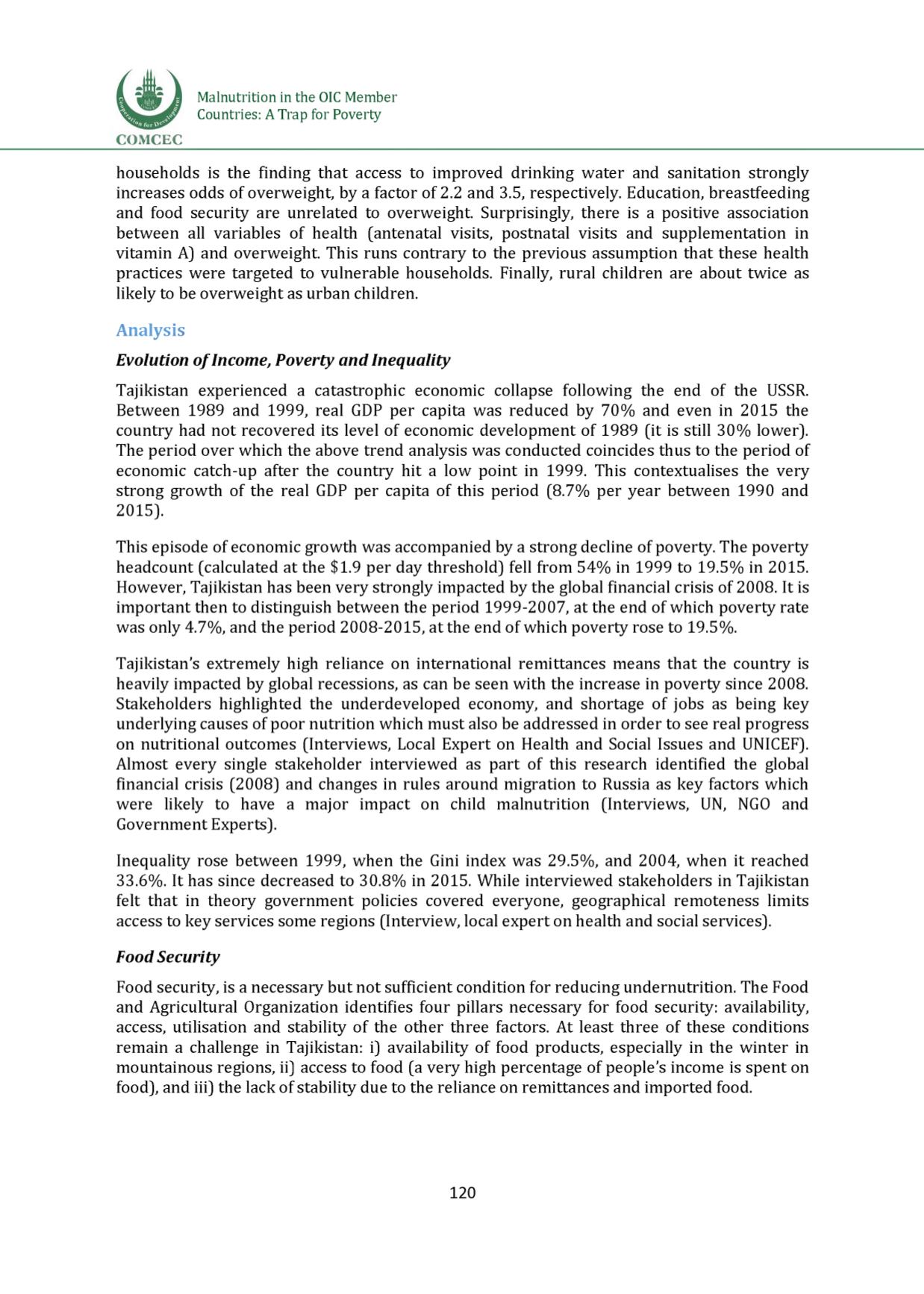

COMCEC
Malnutrition in the OIC Member
Countries: A Trap for Poverty
households is the finding that access to improved drinking water and sanitation strongly
increases odds of overweight, by a factor of 2.2 and 3.5, respectively. Education, breastfeeding
and food security are unrelated to overweight. Surprisingly, there is a positive association
between all variables of health (antenatal visits, postnatal visits and supplementation in
vitamin A) and overweight. This runs contrary to the previous assumption that these health
practices were targeted to vulnerable households. Finally, rural children are about twice as
likely to be overweight as urban children.
Analysis
Evolution of Income, Poverty and Inequality
Tajikistan experienced a catastrophic economic collapse following the end of the USSR.
Between 1989 and 1999, real GDP per capita was reduced by 70% and even in 2015 the
country had not recovered its level of economic development of 1989 (it is still 30% lower).
The period over which the above trend analysis was conducted coincides thus to the period of
economic catch-up after the country hit a low point in 1999. This contextualises the very
strong growth of the real GDP per capita of this period (8.7% per year between 1990 and
2015).
This episode of economic growth was accompanied by a strong decline of poverty. The poverty
headcount (calculated at the $1.9 per day threshold) fell from 54% in 1999 to 19.5% in 2015.
However, Tajikistan has been very strongly impacted by the global financial crisis of 2008. It is
important then to distinguish between the period 1999-2007, at the end of which poverty rate
was only 4.7%, and the period 2008-2015, at the end of which poverty rose to 19.5%.
Tajikistan's extremely high reliance on international remittances means that the country is
heavily impacted by global recessions, as can be seen with the increase in poverty since 2008.
Stakeholders highlighted the underdeveloped economy, and shortage of jobs as being key
underlying causes of poor nutrition which must also be addressed in order to see real progress
on nutritional outcomes (Interviews, Local Expert on Health and Social Issues and UNICEF).
Almost every single stakeholder interviewed as part of this research identified the global
financial crisis (2008) and changes in rules around migration to Russia as key factors which
were likely to have a major impact on child malnutrition (Interviews, UN, NGO and
Government Experts).
Inequality rose between 1999, when the Gini index was 29.5%, and 2004, when it reached
33.6%. It has since decreased to 30.8% in 2015. While interviewed stakeholders in Tajikistan
felt that in theory government policies covered everyone, geographical remoteness limits
access to key services some regions (Interview, local expert on health and social services).
Food Security
Food security, is a necessary but not sufficient condition for reducing undernutrition. The Food
and Agricultural Organization identifies four pillars necessary for food security: availability,
access, utilisation and stability of the other three factors. At least three of these conditions
remain a challenge in Tajikistan: i) availability of food products, especially in the winter in
mountainous regions, ii) access to food (a very high percentage of people's income is spent on
food), and iii) the lack of stability due to the reliance on remittances and imported food.
120
















